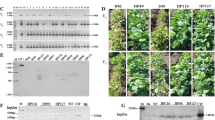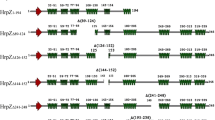Abstract
A sequence homologous to an internal fragment 0.75 kb BstXI of the Pseudomonas syringae pv. syringae hrpZ gene was identified in Pseudomonas syringae pv. aptata NCPPB 2664, the causal agent of bacterial blight in sugar beet, lettuce and other plants, and in E. coli DH10B (pCCP1069) containing the P. syringae pv. aptata hrp gene cluster. PCR with oligonucleotides, based on the hrpZPss gene and used as primers with the total genomic DNA of P. syringae pv. aptata, amplified a 1 kb fragment that hybridized with the probe in highly stringent conditions. The amplicon was cloned into the pGEM-T® plasmid vector, amplified in E. coli DH5α and sequenced. The sequence showed 95%, 83% and 61% identity with those of hrpZPss, hrpZPsg and hrpZPst genes encoding the harpins of the P. syringae pv. syringae, glycinea and tomato, respectively. The amplicon was cloned into the pMAL® expression system. The expressed protein, fused with maltose-binding protein, was cleaved with a specific protease factor Xa, and purified using affinity chromatography. On the basis of the amino acid sequence and its ability to induce HR in tobacco leaves, it was identified as a P. syringae pv. aptata harpin.
Similar content being viewed by others
References
Ádám AL, Pike S, Hoyos ME, Stone JM, Walker JC & Novacky A (1997) Rapid and transient activation of a myelin basic protein kinase in tobacco leaves treated with harpin from Erwinia amylovora. Plant Physiol. 115: 853-860
Alfano J & Collmer A (1997) The type III (Hrp) secretion pathway of plant pathogenic bacteria: trafficking harpins, Avr proteins, and death. J. Bacteriol. 179: 5655-5662
Altschul SF, Gish W, Miller W, Myers EW & Lipman DJ (1990) Basic local alignment search tool. J. Mol. Biol. 215: 403-410
Ausubel FM, Brent R, Kingston RE, Moore DD, Seidman JG, Smith JA & Struhl K (1987) Current Protocols in Molecular Biology. Wiley J & Sons, NY
Baker CJ, Orlandi EW & Mock NM (1993) Harpin, an elicitor of the hypersensitive response in tobacco caused by Erwinia amylovora, elicits active oxygen production in suspension cells. Plant Physiol. 102: 1341-1344
Bauer DW, Garr ER, Kim JF, Norelli JL, Aldwinckle HS & Beer SV (1999) New approaches to the development of transgenic plants resistant to fire blight. Acta Horticult. 489: 301-304
Birnboim HC (1983) A rapid alkaline extraction method for the isolation of plasmid DNA. In: Wu L, Grossman J & Wo K (Eds) Method in Enzymology, Vol 100 (pp 243-255). Academic Press, USA
Bogdanove AJ, Beer SV, Bonas U, Boucher CA, Collmer A, Coplin DL, Cornelis GR, Huang H-C, Hutcheson SW, Panopoulos NJ & Van Gijsegem F (1996) Unified nomenclature for broadly conserved hrp genes of phytopathogenic bacteria. Mol. Microbiol. 20: 681-683
Charkowski A, Huang H-C & Collmer A. (1997) Altered localisation of HrpZ in Pseudomonas syringae pv. syringae hrp mutants suggests that different components of the type III secretion pathway control protein translocation across the inner and outer membranes of Gram-negative bacteria. J. Bacteriol. 179: 3866-3874
Devereaux J, Haeberli P & Smithies O (1984) A comprehensive set of sequence analysis programs for the VAX. Gene 12: 387-395
Gopalan S, Bauer DW, Alfano J, Loniello AO, He SY & Collmer A (1996) Expression of the Pseudomonas syringae avirulence protein AvrB in plant cells alleviates its dependence on the hypersensitive response and pathogenicity (Hrp) secretion system in eliciting genotype-specific hypersensitive cell death. Plant Cell 8: 1095-1105
He SY (1998) Type III protein secretion systems in plant and animal pathogenic bacteria. Annu. Rev. Phytopathol. 36: 363-392
He SY, Huang H-C & Collmer A (1993) Pseudomonas syringae pvs. syringae harpin Pss: a protein that secreted via the hrp pathway and elicits the Hypersensitive Response in plants. Cell 73: 1255-1266
Hoyos ME, Stanley CM, He SY, Pike S, Pu X-A & Novacky A (1996) The interaction of harpinPss with plant cell walls. Mol. Plant-Microbe Interact. 9: 608-616
Huang H-C, Lin RH, Chang CJ, Collmer A & Deng WL (1995) The complete hrp gene cluster of Pseudomonas syringae pvs. syringae 61 includes two blocks of genes required for harpinPss secretion that are arranged colinearly with Yersinia ysc homologs. Mol. Plant-Microbe Interact. 8: 733-746
Huynh TV, Dahlbeck D & Staskawicz BJ (1989) Bacterial blight of soybean: regulation of a pathogen gene determining host cultivar specificity. Science 245: 1374-1377
Jin Q-L, Liu N-Z, Qiu J-L, Li D-B & Wang J (1997) A truncated fragment of harpinPss induces systemic resistance to Xanthomonas campestris pv. oryzae in rice. Physiol. Mol. Plant Pathol. 51: 243-257
Kim JF, Wei Z-M & Beer SV (1997) The hrpA and hrpC operons of Erwinia amylovora encode components of a type III pathway that secretes harpin. J. Bacteriol. 179: 1690-1697
Kim JF, Bauer DW, Bogdanove AJ, Wei Z-M, Dong H & Beer SV (1999) Secreted enigmatic proteins of Erwinia amylovora-For good and evil. Acta Horticult. 489: 371-375
Lindgren PB (1997) The role of hrp genes during plant-bacterial interactions. Annu. Rev. Phytopathol. 35: 129-152
Lowry OH, Rosebrough NJ, Farr AL & Randall RJ (1951) Protein measurement with the Folin reagent. J. Biol. Chem. 193: 265-275
Maryke A, Mansvelt EL & Bellstedt DU (1995) Production of a harpin elicitor by Pseudomonas syringae pv. syringae isolated from a nectarine tree. In: Rudolph K, Burr TJ, Mansfield JW, Stead D, Vivian A & Von Kretzell J (Eds) Pseudomonas syringae Pathovars and Related Pathogens (pp 333-338). Kluwer Academic Publishers, Dordrecht
Minardi P & Musa AR (1996) Determinants of hypersensitivity in Pseudomonas syringae: role of extracellular proteins in plantmicrobe interactions. In: AAA BIOTEC. Advanced Biotechnologies for Agriculture, Nutrition and Environment. Abstracts (p 97). Stampa Litografia Tosi, Ferrara
Minardi P (1995a) Cloning of genes required for hypersensitivity and pathogenicity in Pseudomonas syringae pv. aptata. Antonie van Leeuwenhoek. 67: 201-210
Minardi P (1995b) Altered expression of Erwinia amylovora hrp genes in tobacco leaves pretreated with bacterial proteinlipopolysaccharides. J. Phytopathol. 143: 199-205
Pike SM, Adam AL, Pu X-A, Hoyos ME, Laby R, Beer SV & Novacky A (1998) Effects of Erwinia amylovora harpin on tobacco leaf cell membranes are related to leaf necrosis and electrolyte leakage and distinct from perturbations caused by inoculated E. amylovora. Physiol. Mol. Plant Pathol. 53: 39-60
Preston G, Huang H-C, He SY & Collmer A (1995) The hrpZ proteins of Pseudomonas syringae pvs. syringae, glycinea, and tomato are encoded by an operon containing Yersinia ysc homologs and elicit the hypersensitive response in tomato but not soybean. Mol. Plant-Microbe Interact. 8: 717-732
Roine E, Wei W, Yuan J, Nurmiaho-Lassila EL, Kalkkinen N, Romantschuk m, Wei WS, Juan J & He SY (1997) Hrp pilus: an hrp-dependent bacterial surface appendage produced by Pseudomonas syringae pv. tomato DC3000. Proc. Natl. Acad. Sci. USA 94: 3459-3464
Rudolph KWE (1995) Pseudomonas syringae pathovars. In: US Singh, RS Singh & K Kohmoto, (Eds) Pathogenesis and host specificity in plant diseases. Histopathological, biochemical, genetic and molecular bases. Vol I: Prokaryotes (pp 47-138). Pergamon/Elsevier Science Ltd
Sambrook J, Frisch EF & Maniatis TA (1989) Molecular cloning: a laboratory manual. 2nd edn. Cold Spring Harbor Laboratory Press, NY
Strobel NE, Ji C, Gopalan S, Kuc J & He SY (1996) Induction of systemic acquired resistance in cucumber by Pseudomonas syringae pv. syringae 61 HrpZPss protein. Plant J. 9: 431-439
Wei Z-M & Beer SV (1996) Harpin from Erwinia amylovora induces plant resistance. Acta Horticult. 411: 223-225
Author information
Authors and Affiliations
Corresponding author
Rights and permissions
About this article
Cite this article
Musa, A., Minardi, P. & Mazzucchi, U. Identification and expression of the Pseudomonas syringae pv. aptata hrpZPsa gene which encodes an harpin elicitor. Antonie Van Leeuwenhoek 79, 61–71 (2001). https://doi.org/10.1023/A:1010280116487
Issue Date:
DOI: https://doi.org/10.1023/A:1010280116487




